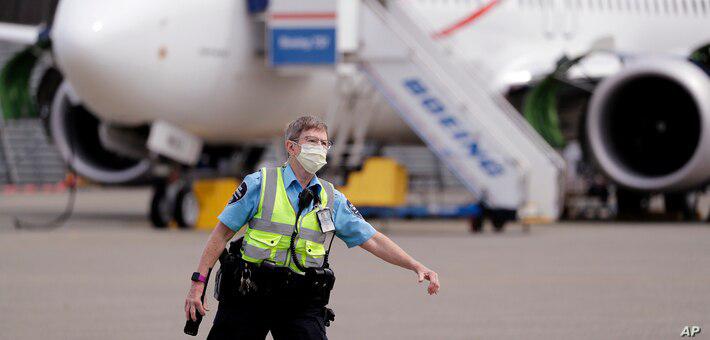Pilots and test crew members from the U.S. Federal Aviation Administration and Boeing Co aim to kick off a certification test campaign for the 737 MAX on Monday, expected to last at least three days, people familiar with the matter told Reuters.
Publish dateSunday 28 June 2020 - 10:43
Story Code : 213137
The flight test is a pivotal moment in Boeing's worst-ever corporate crisis, long since compounded by the COVID-19 pandemic that has slashed air travel and jet demand.
The grounding of the fast-selling 737 MAX in March 2019 after crashes killed 346 people in Ethiopia and Indonesia triggered hundreds of lawsuits, investigations by Congress and the Department of Justice and cut off a key source of Boeing's cash.
After a preflight briefing over several hours, the crew will board a 737 MAX 7 outfitted with special test equipment at Boeing Field near Seattle, one of the people said.
The crew will run methodically scripted mid-air scenarios such as steep-banking turns, progressing to more extreme maneuvers on a route primarily over Washington state.
The flight plan could include touch-and-go landings at the eastern Washington airport in Moses Lake, and a path over the Pacific Ocean coastline, adjusting the course as needed for weather conditions and other factors, one of the people said.
Pilots will also intentionally trigger the reprogrammed stall-prevention software known as MCAS faulted in both crashes, and will likely perform a full aerodynamic stall, the people said.
The tests are meant to ensure that new protections Boeing added to the MCAS flight control system are robust enough to prevent the scenario pilots encountered in both crash flights, when they were unable to counteract the system and grappled with several factors like "stick shaker" column vibrations and other warnings, one of the people said.
Boeing and the FAA declined to comment.
Boeing has wrestled for months with painstaking software system upgrades, wiring changes, documentation, and dress rehearsals. That includes hundreds of hours inside a 737 MAX flight simulator at Boeing's Longacres facility in Renton, Washington, and hundreds of hours in the air on the same 737 MAX 7 test airplane without FAA officials on board.
At least one of those practice flights included the same testing parameters expected on Monday, one of the people said.
After the flights, FAA officials in Washington and the Seattle-area will analyze reams of digital and paperwork flight test data to assess the jetliners' airworthiness.
Likely weeks later, after the data is analyzed and training protocols are firmed up, FAA Administrator Steve Dickson, a former F-15 fighter pilot who has promised that the 737 MAX will not be approved until he has personally signed off on it, will board the same plane to make his assessments, two of the people said.
If all goes well, the FAA would then need to approve new pilot training procedures, among other reviews, and would not likely approve the plane's ungrounding until September, the people said.
That means the jet is on a path to resume U.S. commercial service before year-end, though the process has been plagued by delays for more than a year.
The grounding of the fast-selling 737 MAX in March 2019 after crashes killed 346 people in Ethiopia and Indonesia triggered hundreds of lawsuits, investigations by Congress and the Department of Justice and cut off a key source of Boeing's cash.
After a preflight briefing over several hours, the crew will board a 737 MAX 7 outfitted with special test equipment at Boeing Field near Seattle, one of the people said.
The crew will run methodically scripted mid-air scenarios such as steep-banking turns, progressing to more extreme maneuvers on a route primarily over Washington state.
The flight plan could include touch-and-go landings at the eastern Washington airport in Moses Lake, and a path over the Pacific Ocean coastline, adjusting the course as needed for weather conditions and other factors, one of the people said.
Pilots will also intentionally trigger the reprogrammed stall-prevention software known as MCAS faulted in both crashes, and will likely perform a full aerodynamic stall, the people said.
The tests are meant to ensure that new protections Boeing added to the MCAS flight control system are robust enough to prevent the scenario pilots encountered in both crash flights, when they were unable to counteract the system and grappled with several factors like "stick shaker" column vibrations and other warnings, one of the people said.
Boeing and the FAA declined to comment.
Boeing has wrestled for months with painstaking software system upgrades, wiring changes, documentation, and dress rehearsals. That includes hundreds of hours inside a 737 MAX flight simulator at Boeing's Longacres facility in Renton, Washington, and hundreds of hours in the air on the same 737 MAX 7 test airplane without FAA officials on board.
At least one of those practice flights included the same testing parameters expected on Monday, one of the people said.
After the flights, FAA officials in Washington and the Seattle-area will analyze reams of digital and paperwork flight test data to assess the jetliners' airworthiness.
Likely weeks later, after the data is analyzed and training protocols are firmed up, FAA Administrator Steve Dickson, a former F-15 fighter pilot who has promised that the 737 MAX will not be approved until he has personally signed off on it, will board the same plane to make his assessments, two of the people said.
If all goes well, the FAA would then need to approve new pilot training procedures, among other reviews, and would not likely approve the plane's ungrounding until September, the people said.
That means the jet is on a path to resume U.S. commercial service before year-end, though the process has been plagued by delays for more than a year.
Source : Afghan Voice Agency(AVA)
avapress.net/vdcgww9xuak9qq4.5jra.html
Tags
Top hits







